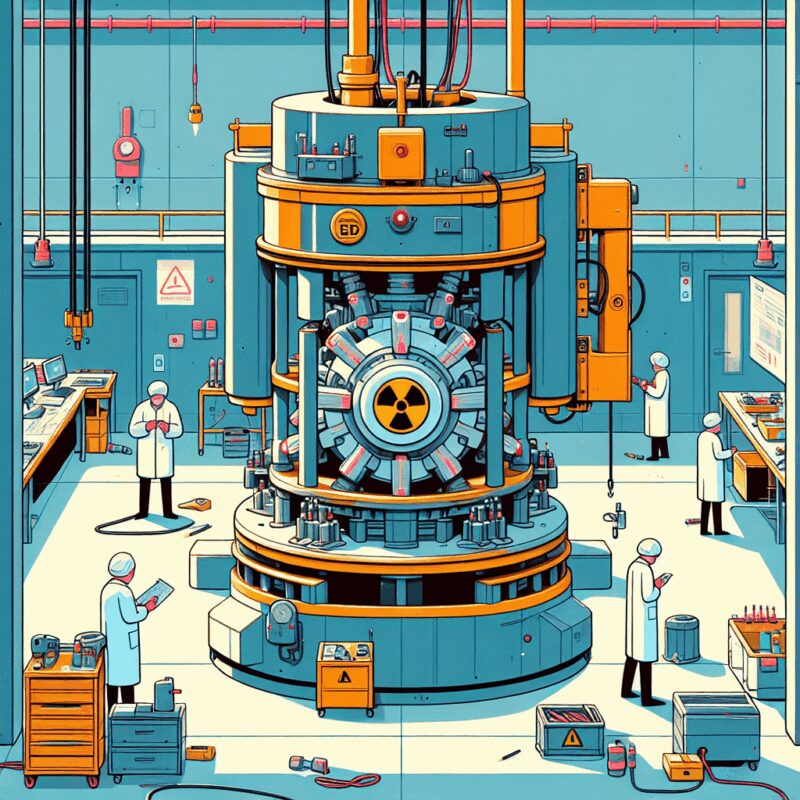
Understanding Proton Decay
Proton decay is a fascinating concept that comes up in the realm of theoretical physics, specifically in the study of Grand Unified Theories (GUTs). To understand proton decay, consider a proton as a stable building block of the universe, much like a brick in a house. Typically, these bricks are incredibly stable and don’t just disappear or change. However, imagine if, after an incredibly long time, one of these bricks just vanished or transformed into something else. This is the essence of proton decay – the idea that protons, which are components of atoms, might not be eternally stable and could eventually transform into lighter particles.
Grand Unified Theories
Grand Unified Theories are like ambitious blueprints that aim to combine the fundamental forces of nature into a single framework. Currently, physicists recognize four fundamental forces: gravity, electromagnetism, the strong nuclear force, and the weak nuclear force. GUTs attempt to unify the latter three, imagining a time in the early universe when they were not distinct forces but rather a single, harmonious force. This unification could potentially explain many mysteries of the universe, including why there is more matter than antimatter and, importantly, how proton decay might occur.
Singlet Seesaw Mechanism for Neutrino Mass GenerationWhy Proton Decay Matters
Understanding why proton decay is significant involves recognizing its potential to reveal new physics beyond our current understanding. If protons can decay, it would mean that matter, as we know it, is not as stable as previously thought. This could provide insights into the early moments of the universe and help refine or redefine our theories about the fundamental workings of everything around us. Proton decay, if observed, would be a groundbreaking discovery, indicating the presence of new particles or forces as predicted by GUTs.
The Quest for Evidence
Detecting proton decay is incredibly challenging because it is predicted to happen over vast timescales, far longer than the current age of the universe. Scientists use large detectors, often located deep underground, to shield them from cosmic rays that could mimic decay events. These detectors, such as Super-Kamiokande in Japan, are filled with large volumes of water or other materials to catch the rare event of a proton decaying. Despite decades of searching, no direct evidence of proton decay has been confirmed, but the quest continues as it promises to unlock new realms of physics.
Application of Renormalization Group Flow in Higher Dimensional TheoriesImplications of Proton Decay
The implications of proton decay extend far beyond confirming theories like GUTs. If protons are not stable, it may suggest that the universe is not eternal in its current form. Over unimaginable timescales, everything composed of matter could eventually decay, leading to a completely different universe. Additionally, proton decay could have implications for understanding dark matter and energy, as new particles arising from decay might interact with these mysterious components of the universe. Thus, studying proton decay is not just about solving a puzzle but also about grasping the future destiny of the cosmos.
Singlet Seesaw Mechanism for Neutrino Mass Generation
Current Theoretical Models
Several theoretical models within GUTs predict proton decay, each with its unique mechanisms and timelines. One well-known model is the SU(5) theory, which suggests that protons could decay into a positron and a neutral pion. Another model, SO(10), provides an even broader framework, potentially incorporating neutrino masses and other phenomena. These models often predict different lifetimes for protons, ranging from 10^31 to 10^36 years. Understanding and testing these models is crucial because they offer pathways to potentially unify not just the forces but also the particles of the universe.
Experimental Challenges
The experimental search for proton decay faces significant challenges, primarily due to the immense timescales involved. Detectors must be both large and sensitive, capable of distinguishing a genuine decay event from background noise. Additionally, advancements in technology and detection methods are continually needed to push the boundaries of what can be observed. Despite these challenges, every experiment refines the parameters of our theories, narrowing down the possible characteristics of proton decay and guiding future research.
Precision Calibration Methods in Top Quark Mass MeasurementThe Future of Research
The future of proton decay research is promising, with new experiments and technologies on the horizon. Projects like the Hyper-Kamiokande in Japan and the Deep Underground Neutrino Experiment (DUNE) in the United States aim to increase the sensitivity and scope of detection efforts. These initiatives are important not only for testing GUTs but also for exploring other aspects of particle physics, such as neutrino interactions. As science advances, the possibility of observing proton decay becomes more tangible, potentially leading to a revolutionary understanding of the universe’s fundamental nature.
Theory of BEC-BCS Crossover and SuperfluidityConclusion
Proton decay remains one of the most intriguing and challenging areas of study in modern physics. Its pursuit is not just about validating or refuting theoretical models but about understanding the deepest laws that govern the universe. While it may take many more years of research and experimentation, the potential rewards are immense, promising to shed light on the very fabric of reality. As the quest continues, each step brings us closer to uncovering the mysteries that lie at the heart of matter and the universe itself.
관련 글: Singlet Seesaw Mechanism for Neutrino Mass Generation
[…] Proton Decay Predictions in Grand Unified Theories […]